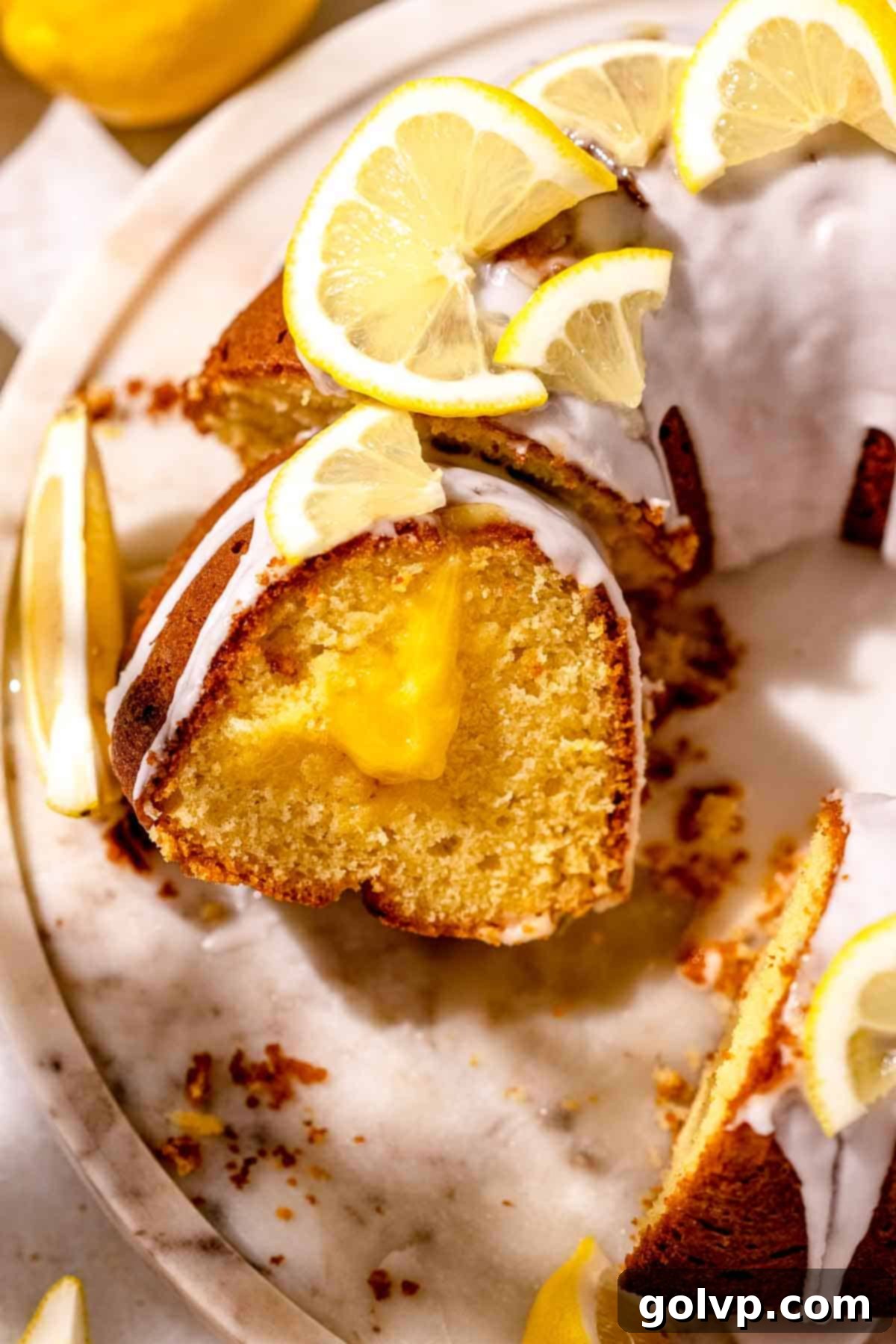Ultimate Lemon Curd Stuffed Bundt Cake: Your Go-To Recipe for Zesty Perfection
Prepare to fall in love with this extraordinary Lemonade Bundt Cake. It’s a symphony of textures and flavors – incredibly soft, beautifully fluffy, and wonderfully moist, each bite bursting with vibrant lemon essence. But the true magic lies within: after baking, this delightful cake is generously filled with luscious, gooey lemon curd, creating a delightful surprise in every slice. Topped with a simple yet perfectly tangy lemon glaze, this isn’t just a cake; it’s the best lemon cake experience you’ll ever have. Whether you’re planning a special brunch or looking for an unforgettable dessert, this recipe is guaranteed to impress.

Please note: Purchasing items through the links in this post helps support this blog, at no additional cost to you. As an Affiliate Product marketer and Amazon Associate, I may earn a commission from qualifying purchases. Your support is greatly appreciated!
Why You Will Absolutely Love This Lemon Bundt Cake Recipe:
This lemon curd bundt cake isn’t just another dessert; it’s a culinary creation designed to delight. Here’s why this particular recipe will quickly become a favorite in your baking repertoire:
- Unforgettable Texture: The cake itself boasts a heavenly texture. It’s incredibly soft, moist, and rich with a buttery crumb that melts in your mouth. The combination of butter and oil, along with sour cream and buttermilk, creates a perfect balance, ensuring a cake that is never dry or crumbly. This is the quintessential bundt cake texture you’ve been searching for!
- Bright, Tangy Glaze: A simple yet powerful lemon glaze is generously drizzled over the cooled cake. This isn’t just a decoration; it’s an integral part of the flavor profile, adding an extra layer of bright, tangy lemon flavor that perfectly complements the rich cake and sweet curd. It also sets beautifully, creating a slightly crisp shell.
- Surprise Gooey Filling: The star of the show is undeniably the hidden lemon curd filling. Piped directly into the center of the cake after baking, it creates a luscious, gooey surprise in every slice. This addition elevates the cake from merely good to truly spectacular, adding an extra dimension of intense lemon flavor and a wonderfully soft, almost molten texture.
- Remarkably Easy to Make: Despite its impressive appearance and complex flavor, this lemon bundt cake is surprisingly straightforward to prepare. The instructions are clear, and with the option to use pre-made lemon curd, you can cut down on preparation time without sacrificing flavor. It’s a perfect recipe for both novice and experienced bakers alike.
- Packed with Fresh Lemon Flavor: From the zest in the cake batter to the fresh lemon juice in the glaze and the bright lemon curd filling, this cake is an absolute celebration of lemon. Every component contributes to a truly authentic and refreshing citrus experience.
[feast_advanced_jump_to]
Clever Ways to Fill a Bundt Cake After Baking
Filling a bundt cake after it’s baked is a fantastic way to add a delightful surprise and extra moisture, much like filling a donut or a cupcake. The key is to create pockets for your filling without compromising the cake’s structure. Here’s a simple, effective method:
First, ensure your bundt cake has completely cooled. This prevents the filling from melting or being absorbed too quickly, keeping it distinct and gooey. Next, grab a long, thin tool like a chopstick, a wooden skewer, or even the handle of a wooden spoon.
Carefully poke about eight to ten holes into the thickest parts of the cake. Aim for the wider, more substantial sections rather than the thinner edges or the very bottom. Don’t poke all the way through to the serving plate; you want to create a pocket for the curd. Once a hole is poked, gently wiggle the tool around to widen the cavity slightly. This creates more space for the lemon curd, ensuring a generous filling.
Once your cavities are ready, scoop your cooled lemon curd into a piping bag fitted with a round tip. If you don’t have a piping bag, a sturdy Ziploc bag with a corner snipped off will work just as well. Insert the tip of the piping bag deep into each hole you’ve created. Gently squeeze the bag, filling each cavity with as much lemon curd as it can hold. As you fill, you might see a little curd peek out of the top, which is perfectly normal.
After all the holes are filled, use a clean spatula or the back of a spoon to gently scrape off any excess curd that has spilled onto the surface of the cake. Don’t worry about perfection here; the tangy lemon glaze you’ll pour over the top will beautifully cover these entry points, making the filling a delightful secret until the cake is sliced.
Make-Ahead Tips for Convenience
This Lemon Curd Bundt Cake is an excellent choice for entertaining, as many components can be prepared in advance, saving you time on the day of your event. Here’s how to get a head start:
Lemon Curd: The lemon curd can be made up to a few days (3-5 days) in advance. Store it in an airtight container or jar in the refrigerator. Homemade lemon curd truly offers a superior flavor and texture that elevates this cake, but if time is of the essence, a good quality store-bought lemon curd is a convenient alternative. Just make sure it’s completely chilled before you try to fill the cake.
Bundt Cake: The baked bundt cake itself can also be prepared a day ahead of time. Once baked, let it cool completely to room temperature before filling and glazing. Store the cooled, unfilled cake in an airtight container at room temperature. For optimal freshness, it’s best to fill and glaze the cake just a few hours before serving. If you need to fill and glaze it a day in advance, store the finished cake in the refrigerator and allow it to come to room temperature for at least 30-60 minutes before serving, as this will soften the butter in the cake and enhance its moist texture.
Storage Instructions for Freshness
Proper storage is essential to keep your Lemon Curd Bundt Cake tasting fresh and moist for as long as possible:
The filled and glazed lemon bundt cake will keep beautifully in the refrigerator for up to three days. To maintain its moisture and prevent it from drying out, always store it in an airtight container. This also helps to protect the delicate flavors from absorbing any fridge odors.
For longer storage, leftover filled cake also freezes exceptionally well. Wrap individual slices or the entire cake (if it fits) tightly in plastic wrap, then place it in an airtight freezer-safe container or a heavy-duty freezer bag. It can be stored in the freezer for up to two months. When you’re ready to enjoy it, thaw the cake overnight in the refrigerator.
A crucial tip for serving: regardless of whether it was refrigerated or frozen, make sure to let the cake come to room temperature before eating. This allows the butter in the cake to soften up again, restoring its incredibly moist and tender texture, which is a key characteristic of a perfect bundt cake.
Essential Ingredients for Your Lemon Bundt Cake
While full steps and ingredient quantities are detailed in the recipe card below, reviewing these key ingredients will provide you with crucial tips for achieving the best results and understanding their role in this delicious Lemon Curd Bundt Cake!
- Lemon Curd: This is the heart of the “stuffed” element. While homemade lemon curd is incredibly easy to make and offers a much fresher, more vibrant flavor that truly shines in this cake, a good quality store-bought version can be used in a pinch for convenience. Just ensure it’s well-chilled before filling.
- Fresh Lemons: The star of the show! Always opt for fresh lemons for both the zest and the juice. The zest carries potent lemon oils, infusing the cake batter with an intense, aromatic lemon flavor that extracts beautifully when rubbed with sugar. Fresh juice provides a bright, tangy counterpoint that bottled juice simply cannot replicate.
- Unsalted Butter: Good quality, real unsalted butter is fundamental for flavor and structure. It contributes to the cake’s rich, tender crumb. It’s crucial that your butter is softened to room temperature before mixing. This allows it to cream properly with the sugar and oil, creating air pockets that contribute to a light and fluffy cake texture.
- Vegetable Oil: The addition of a neutral-flavored oil, such as grapeseed, canola, or light olive oil, works synergistically with butter. While butter provides flavor, oil ensures extra moisture and tenderness, preventing the cake from drying out over time. Avoid strong-flavored oils like coconut or extra virgin olive oil, which can impart unwanted tastes.
- All-Purpose Flour: For the most accurate and consistent baking results, weighing your flour is highly recommended. If you don’t have a kitchen scale, use the “spoon and level” method: gently stir the flour in its bag or container, then spoon it lightly into your measuring cup. Level off the excess with the flat edge of a knife, being careful not to pack the flour down. Too much flour can lead to a dry, dense cake.
- Full-Fat Sour Cream: This ingredient is a secret weapon for an incredibly moist and tender crumb. The fat content and acidity in full-fat sour cream contribute to richness and a subtle tang that enhances the lemon flavor, while also reacting with the baking powder to create a lighter texture.
- Buttermilk: Store-bought buttermilk provides the best results for this recipe, contributing to the cake’s tenderness and light texture due to its acidity. While you can make a DIY version by adding lemon juice or vinegar to regular milk, the consistency and chemical reaction won’t be as precise, potentially affecting the final texture of your bundt cake.

Step-by-Step Guide: Crafting Your Perfect Lemon Bundt Cake
Follow these detailed steps to create a beautiful and delicious lemon bundt cake:
Step 1 – Prepare Your Bundt Pan: Preheat your oven to 350°F (180°C). This is a crucial first step for any bundt cake. Take a cold piece of unsalted butter and thoroughly rub it all along the inside of your bundt pan, ensuring every nook and cranny is completely covered. The cold butter will create a solid barrier. Then, add a tablespoon of all-purpose flour into the greased pan and tap it all around to evenly distribute the flour, creating a non-stick coating. Flip the pan over and tap out any excess flour. Set your perfectly prepared pan aside.
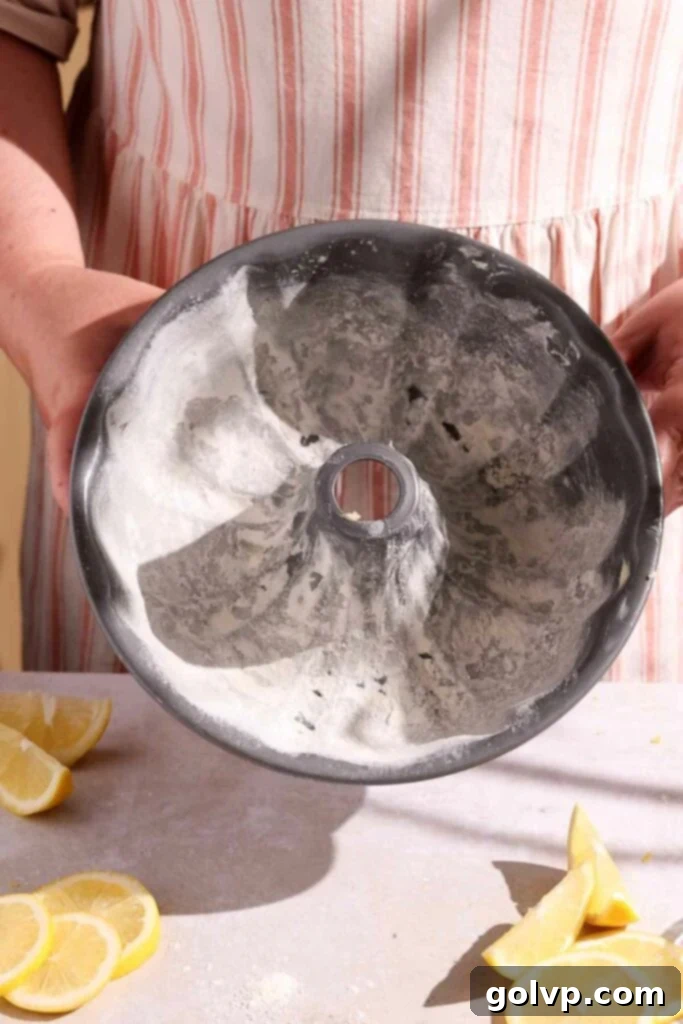
Step 2 – Infuse the Sugar with Lemon Zest: In a large mixing bowl, combine the granulated sugar and the lemon zest from two fresh lemons. Using your fingers, rub the zest into the sugar for about a minute. This technique helps to release the aromatic oils from the lemon zest, infusing the sugar with a deeper, more pronounced lemon flavor.
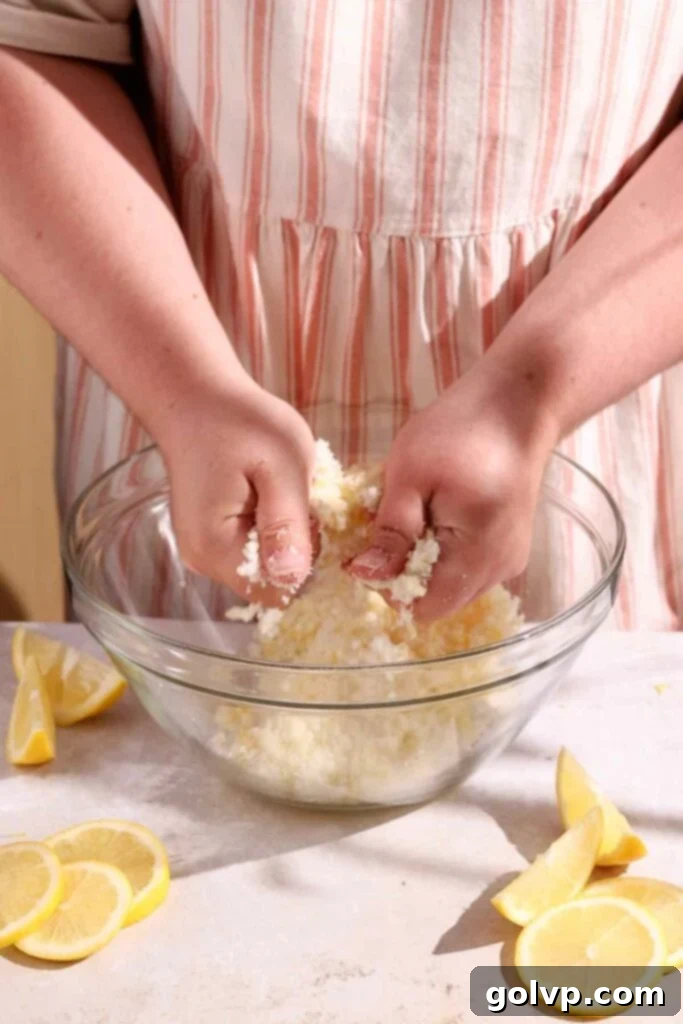
Step 3 – Cream the Fats and Sugar: To the same bowl, add the vegetable oil, softened unsalted butter, and sea salt. Using an electric mixer, beat the mixture on medium-high speed until it becomes light, fluffy, and pale in color. This creaming process incorporates air, which is vital for a tender cake. Remember to stop halfway through and scrape down the sides and bottom of the bowl to ensure everything is evenly combined.
Step 4 – Add Eggs Gradually: Add the large eggs, one by one, beating thoroughly after each addition until fully incorporated. After each egg, scrape down the bowl to ensure all ingredients are well mixed and the batter remains emulsified. This gradual addition prevents the batter from separating.
Step 5 – Incorporate Wet Ingredients: Into the same bowl, add the room temperature sour cream and freshly squeezed lemon juice. Beat on low speed until just combined. Again, scrape the bowl thoroughly to ensure all ingredients are fully integrated.
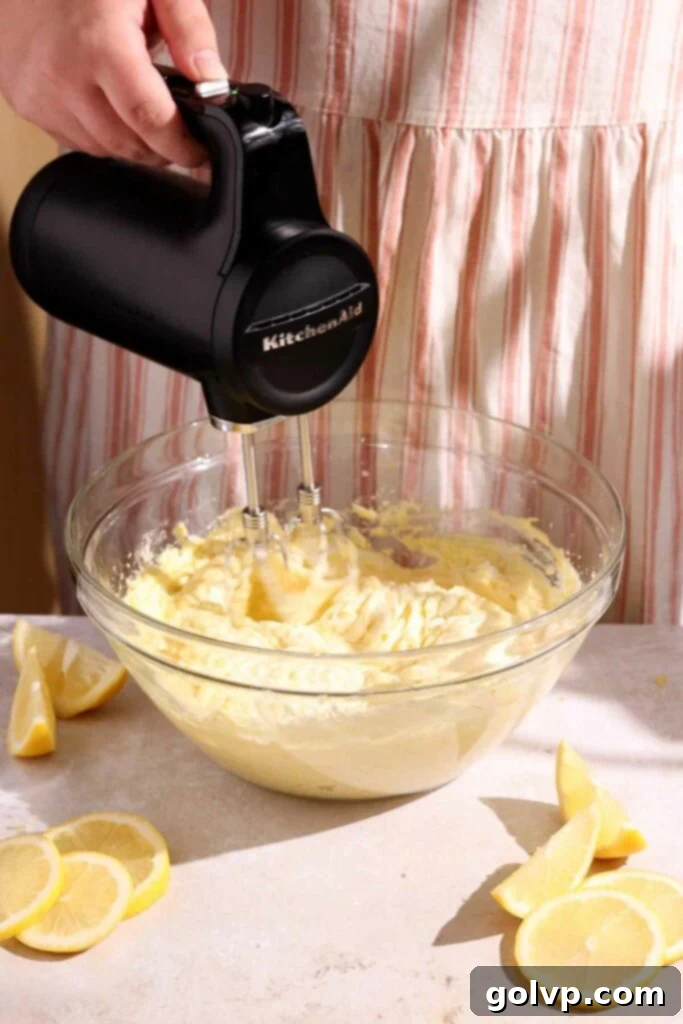
Step 6 – Introduce Dry Ingredients (First Half): Sift half of the all-purpose flour and all of the baking powder directly into the wet ingredients. Using a spatula, gently fold the dry ingredients into the wet until they are mostly combined. Be careful not to overmix at this stage.
Step 7 – Alternate with Buttermilk and Remaining Flour: Add the buttermilk to the bowl and fold a few times to partially incorporate. Then, sift the remaining flour into the same bowl. Continue to fold gently with your spatula just until no dry streaks of flour remain. Overmixing the batter once flour is added can lead to a tough cake, so mix only until just combined.
Step 8 – Bake the Bundt Cake: Carefully scoop the thick, luscious batter into your prepared bundt pan, spreading it evenly. Bake for 55-60 minutes, or until a wooden toothpick inserted into the center of the cake comes out clean with only a few moist crumbs attached. This indicates the cake is fully cooked but still delightfully moist.
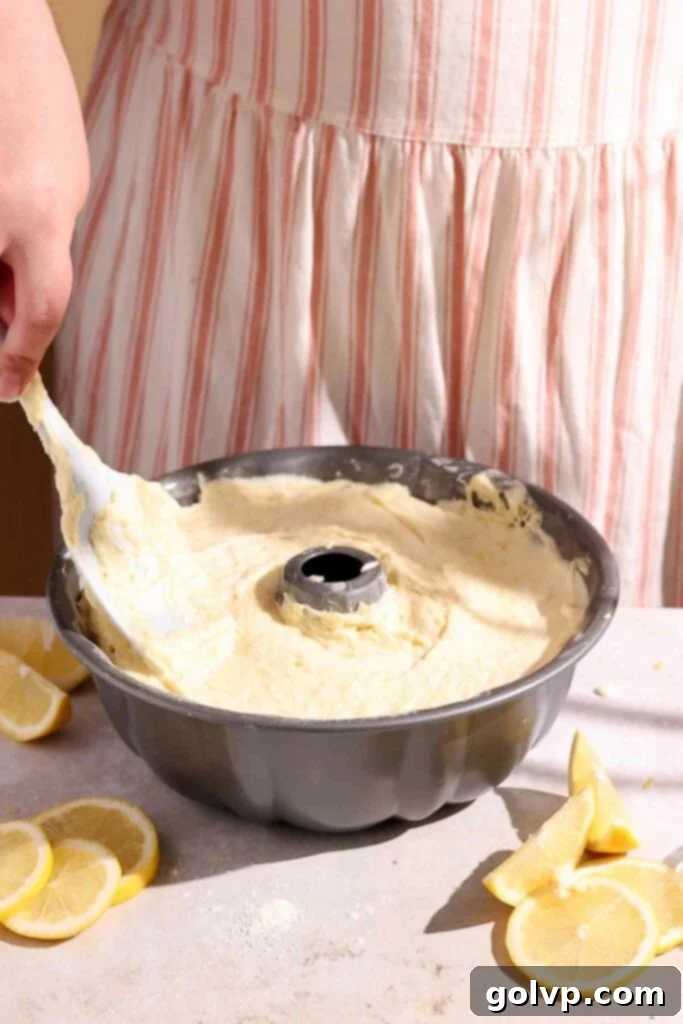
Step 9 – Cool and Release: Allow the lemonade bundt cake to cool inside the pan for precisely 10 minutes. This crucial resting period helps the cake firm up slightly, making it easier to release. After 10 minutes, place a serving plate or cooling rack on top of the bundt pan and, using oven mitts to protect your hands, carefully flip the pan over. Gently tap the top of the pan a few times to help release the cake, then lift the pan off. Let the cake cool completely on the wire rack before proceeding to the filling stage.
How to Gorgeously Fill Your Bundt Cake
Once your bundt cake is completely cooled, it’s time for the delicious lemon curd surprise!
Step 1 – Create the Filling Holes: Grab a few skewers or chopsticks. Carefully poke about eight holes through the thickest parts of the bundt cake, making sure not to go all the way to the bottom. Once poked, gently wiggle the skewer around to create wider openings, allowing for a generous amount of lemon curd to be piped in. Aim for a good, sturdy pocket within the cake.
Step 2 – Pipe in the Lemon Curd: Take a piping bag (or a large zippered bag with a corner snipped off) and fill it with your cooled homemade or store-bought lemon curd. Insert the tip of the piping bag into the prepared holes in the cake. Slowly and steadily push out as much curd as each hole will comfortably hold. Repeat this process for all the holes, aiming to fill the bundt cake with as much luscious lemon curd as possible. Don’t worry if a little curd overflows; simply use a clean spatula or the back of a spoon to gently scrape any excess lemon curd off the top of the cake, preparing it for the glaze.
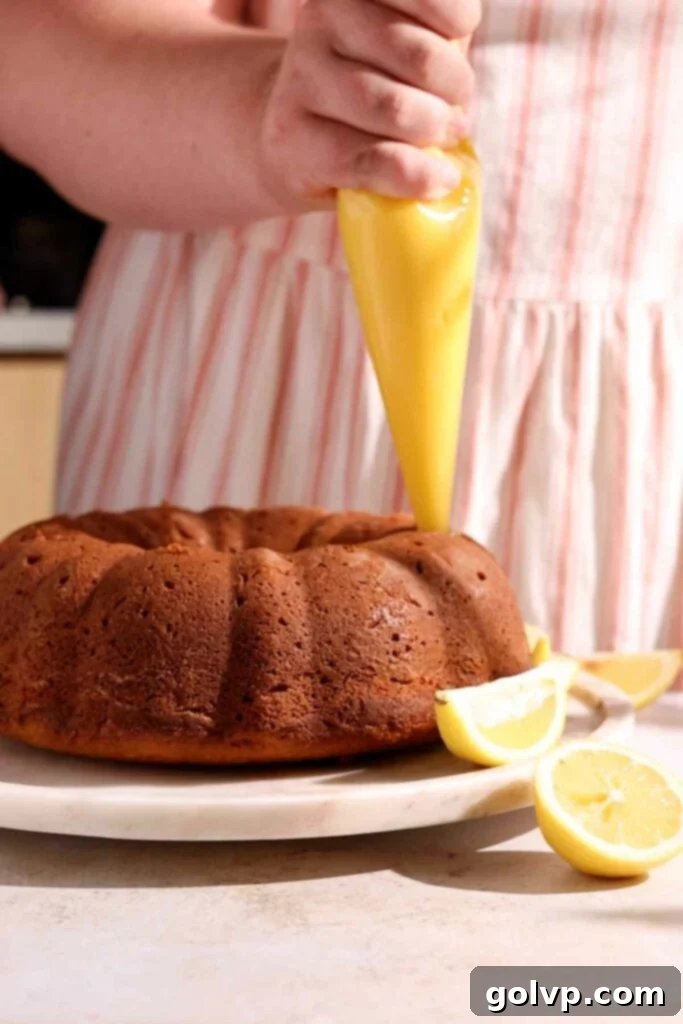
Step-by-Step: Crafting Your Tangy Lemon Glaze
The perfect finishing touch for your lemon bundt cake is a vibrant, tangy glaze:
Step 1 – Prepare the Glaze Mixture: In a medium bowl, add the powdered sugar. Begin adding the freshly squeezed lemon juice, one tablespoon at a time. Whisk or stir vigorously with a spoon after each addition. Continue adding lemon juice and stirring until you achieve your desired consistency. For a thick, spreadable glaze that beautifully cascades down the cake, use less juice. If you prefer a thinner, more translucent glaze, add a little more. The goal is a smooth, lump-free mixture.
Step 2 – Glaze and Serve: Once your bundt cake has cooled completely and is filled, carefully pour the prepared lemon glaze evenly over the top. If needed, use the back of a spoon to gently spread the glaze, allowing it to drip attractively down the sides. Let the glaze set for about 10-15 minutes to firm up slightly. For an extra touch of elegance, garnish with fresh lemon slices (optional) before slicing the cake into pieces and serving. Enjoy the bright, zesty goodness!
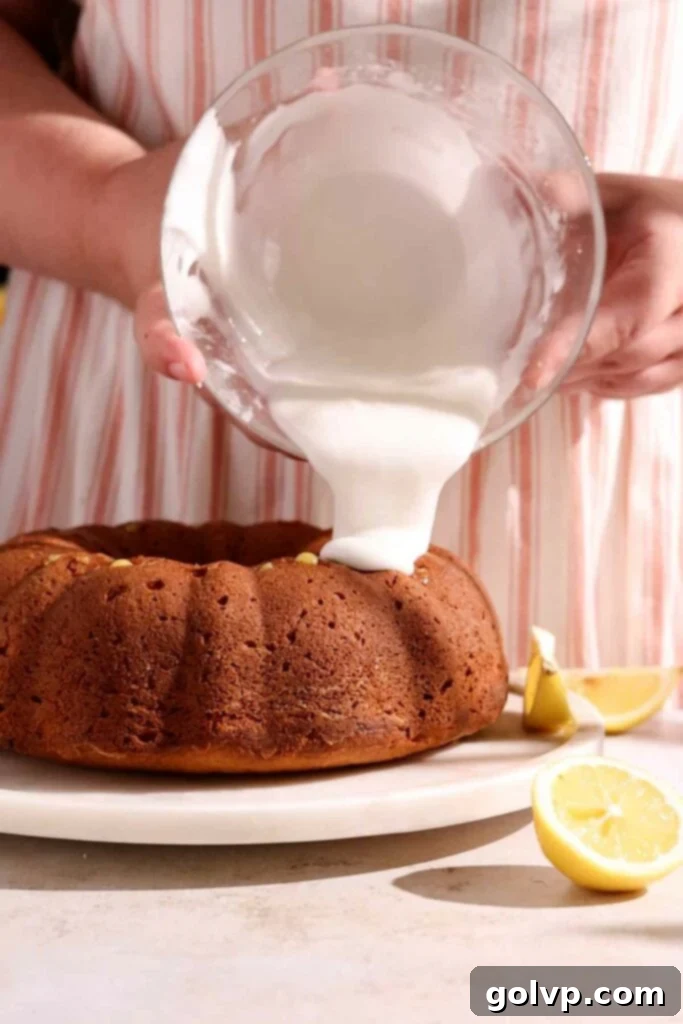
Frequently Asked Questions About Baking Bundt Cakes
Several factors can contribute to a sunken or dense bundt cake. Firstly, ensure you don’t skip the initial step of creaming together the butter, oil, and sugar. This process incorporates air, giving the cake its lift and light texture. Secondly, check the expiration date of your baking powder; old leavening agents lose their potency. Overmixing the batter once the flour is added is another common culprit – this develops too much gluten, resulting in a tough, dense cake. Stop mixing as soon as you no longer see streaks of dry flour. Lastly, improper baking time can cause issues. Undercooking will leave the center collapsed, while overbaking can lead to a dry, crumbly texture. Aim for a toothpick inserted into the center to come out with just a few moist crumbs attached.
Flour is notoriously tricky to measure accurately by volume alone. Even a slight variation can drastically impact the final texture of your cake, leading to a dry, dense, or overly crumbly result. For the most precise and consistent results, always weigh your flour using a kitchen scale – this is the golden standard for baking. If a scale isn’t available, use the “spoon and level” method: gently stir the flour in its container to aerate it, then spoon it lightly into your measuring cup until overflowing. Use the flat edge of a knife or a straight spatula to level off the excess, being careful not to pack the flour into the cup. Never scoop directly from the bag, as this compacts the flour and can add up to 25% more than intended.
A sticking bundt cake can be incredibly frustrating. Start with a good quality non-stick bundt pan. If your pan is older and has seen a lot of use, its non-stick coating might be worn, in which case replacing it could be beneficial. The most critical step is proper greasing and flouring: use a piece of cold butter (or vegetable shortening/oil) and meticulously grease every surface of the pan – every curve, crevice, and corner. Then, add about a tablespoon of all-purpose flour into the pan. Rotate and tap the pan vigorously to ensure the flour adheres completely to the greased surfaces. Invert the pan and tap out any excess flour. This creates a release layer that almost guarantees a clean release.
Batter splitting, often appearing lumpy or curdled, usually occurs when ingredients, particularly eggs and butter, are at different temperatures. For instance, adding cold eggs to creamed butter can cause the butter to seize and separate. Don’t fret if this happens; while it might look unappetizing, the batter will typically come back together once you add the dry ingredients (flour). To prevent splitting, always ensure all your ingredients, especially butter, eggs, sour cream, and buttermilk, are at room temperature. This allows them to emulsify smoothly and create a homogeneous batter.
While you can create a DIY buttermilk substitute in a pinch by adding a tablespoon of lemon juice or white vinegar to regular milk and letting it sit for 5-10 minutes, for optimal texture and flavor in baking, it’s highly recommended to use store-bought buttermilk. Commercial buttermilk has a thicker consistency and a more consistent acidity that yields superior results in baked goods, contributing to a more tender and moist crumb that the homemade substitute often can’t quite match.
Discover More Zesty Lemon Recipes:
- Lemon White Chocolate Cookies
- Lemon Curd Cookies
- Lemon Butter Cake
- Lilac Cake with Lemon
Happy baking, and may your kitchen be filled with the delightful aroma of fresh lemon!
Did you fall in love with this recipe? I would absolutely adore for you to rate this recipe and share your thoughts and experiences in the comments section below! Your feedback means the world. Don’t forget to share your beautiful creation on Instagram and tag @flouringkitchen. For more delicious recipe ideas and to save your favorites, be sure to follow me on Pinterest.
📖 Recipe

Lemonade Bundt Cake with Lemon Curd Filling
Mary
Pin Recipe
Shop Ingredients
Equipment
-
Standard non-stick bundt pan (12 cups)
Ingredients
Bundt Cake
- 1 cup granulated sugar
- 2 lemons zested
- ¼ cup vegetable oil
- 1 cup unsalted butter softened
- ¼ teaspoon sea salt
- 5 large eggs room temperature
- ½ cup sour cream room temperature
- 2 tablespoons lemon juice freshly squeezed
- 3 ¼ cup all purpose flour 390g
- 2 ½ teaspoon baking powder
- ¾ cup buttermilk room temperature
- 1 cup lemon curd
Glaze
- 2 cups powdered sugar
- 2-4 tablespoons lemon juice freshly squeezed
- lemon slices for garnish optional
Shop Ingredients on Jupiter
Instructions
Bundt Cake
-
Preheat oven to 350°F (180°C). Rub a cold piece of butter all along the inside of a bundt pan, ensuring it’s completely covered. Add a tablespoon of flour into the pan and tap it to distribute the flour everywhere. Flip the pan over to remove the excess. Set aside for later.
-
In a large bowl, combine granulated sugar and lemon zest. Rub the zest and sugar together with your fingers until fragrant.1 cup granulated sugar, 2 lemons
-
Add vegetable oil, softened unsalted butter, and sea salt into the same bowl. Beat with an electric mixer until the mixture is light and fluffy. Scrape down the bowl halfway through to ensure even mixing.¼ cup vegetable oil, 1 cup unsalted butter, ¼ teaspoon sea salt
-
Add large eggs one by one, beating well after each egg and scraping down the bowl as needed to ensure smooth incorporation.5 large eggs
-
Into the same bowl, add room temperature sour cream and freshly squeezed lemon juice. Beat briefly to combine, then scrape the bowl once more.½ cup sour cream, 2 tablespoons lemon juice
-
Sift half of the all-purpose flour and all of the baking powder into the same bowl. Gently fold with a spatula until the dry ingredients are mostly combined with the wet mixture.3 ¼ cup all purpose flour, 2 ½ teaspoon baking powder
-
Add the room temperature buttermilk and fold a few times. Sift the remaining flour into the bowl and continue to fold just until no dry streaks of flour are visible. Be careful not to overmix.¾ cup buttermilk
-
Scoop the prepared batter evenly into the greased and floured bundt pan. Bake for 55-60 minutes, or until a toothpick inserted into the center comes out clean with a few moist crumbs attached.
-
Allow the bundt cake to cool inside the pan for 10 minutes. Place a serving plate on top of the pan and, using oven mitts, carefully flip it over. Gently tap the top of the pan a few times to help release the cake, then lift the pan off. Let the cake cool completely on a wire rack before filling.
-
Using skewers or chopsticks, poke eight holes through the thickest parts of the cooled bundt cake. Gently wiggle the tool to create good openings, ensuring not to poke all the way through to the bottom.
-
Fill a piping bag or a large zippered bag with cooled lemon curd and snip off a corner. Insert the piping bag into the poked holes in the cake. Gently push out as much curd as each hole will hold. Repeat with the remaining holes, filling the bundt cake generously. Scrape any excess lemon curd off the top of the cake.1 cup lemon curd
Glaze
-
In a medium bowl, combine powdered sugar with freshly squeezed lemon juice, adding it one tablespoon at a time. Whisk or stir with a spoon after each addition until a thick, spreadable glaze forms (adjust juice for desired consistency).2 cups powdered sugar, 2-4 tablespoons lemon juice
-
Pour the prepared glaze over the cooled, filled bundt cake. Spread with a spoon if needed to cover evenly. Let the glaze set for 10-15 minutes. Garnish with lemon slices (optional), then cut the cake into pieces and serve.lemon slices for garnish
Notes
Tried this recipe?Let us know how it was!
